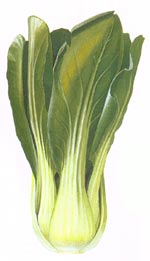 Bok
Choy is thought to be the oldest of the Asian greens. Bok Choy,
otherwise known as Bak Choy, Paak Choy, Chinese chard cabbage and Chinese
mustard cabbage is a unique looking vegetable which is a member of the
cabbage family. It has been cultivated in China since at least the 5th
century and in Europe since the 18th century. Hong Kong farmers grow
over 20 kinds of Bok Choy, but you'll only find a couple popular varieties
in the U.S.
Bok
Choy is thought to be the oldest of the Asian greens. Bok Choy,
otherwise known as Bak Choy, Paak Choy, Chinese chard cabbage and Chinese
mustard cabbage is a unique looking vegetable which is a member of the
cabbage family. It has been cultivated in China since at least the 5th
century and in Europe since the 18th century. Hong Kong farmers grow
over 20 kinds of Bok Choy, but you'll only find a couple popular varieties
in the U.S.
Bok Choy has been cultivated in China for centuries and is now commonly
grown in Alberta, Canada and in California, USA. Bok Choy is also
grown in Europe where it was introduced in the 1700's.
Currently, you can buy Bok Choy in many ethnic grocery stores, and in many larger supermarket chains. Bok Choy is becoming popular to use for cooking because it has a delicious unique taste of its own. Whatever the variety, the stalks are mild and crunchy and the leaves pleasantly tangy.
Recipe for Stir-Fried Bok Choi:
Basic Stir-fry with Peanut Oil and Garlic
-
5-6 small Bok Choy plants (I usually buy them in a small bag)
-
3 Tb peanut oil
-
1 tsp sugar
-
3-4 minced garlic cloves (I use a garlic hand press)
-
1 pinch of salt (NOTE: Be careful not to add too much salt, because the soy sauce already has salt. Literally, just add a small pinch, i.e., what you can pinch between your fingers)
-
3 Tablespoons soy sauce
-
Cut off Bok Choy base and cut into about 4-6 pieces. Cut off leaves but leave some of the stems on them. Chop remaining stems into about 1" pieces. The big leaves will shrivel down in size considerably when you cook them.
-
Preheat wok. Pour peanut oil in. Add stems, base pieces, and diced garlic, tossing over high heat until somewhat softened (about 2 minutes).
-
Add Bok Choy leaves. Add sugar and salt. Toss another 2 minutes. You may want to reduce your heat a bit at this point. Also, it's ok to add another Tablespoon or two of peanut oil if you'd like.
-
Add 3 Tablespoons of soy sauce and stir well. Taste to make sure you like it. The only problem I've ran into is adding too much salt. Remember, just a pinch. If you want more salt, you can add just a little more soy sauce, which contains salt. You can always add more salt, but you can't take any out. So less is better to start.
Nutritional Highlights
Bok Choy offers nutritional assets similar to those of other cabbages. It is rich in vitamins A and C and contains significant amounts of nitrogen compounds known as indoles, which appear to lower the risk of various forms of cancer. Bok Choy is also a good source of folic acid. With its deep green leaves, Bok Choy has more beta-carotene than other cabbages, and supplies considerably more calcium. It is very low in calories (15 per 1/2 cup), and depending on the soil itís grown in, it can have a fair to good amount of calcium, potassium, phosphorous, and iron.
This is one of my favorite meals to cook.
